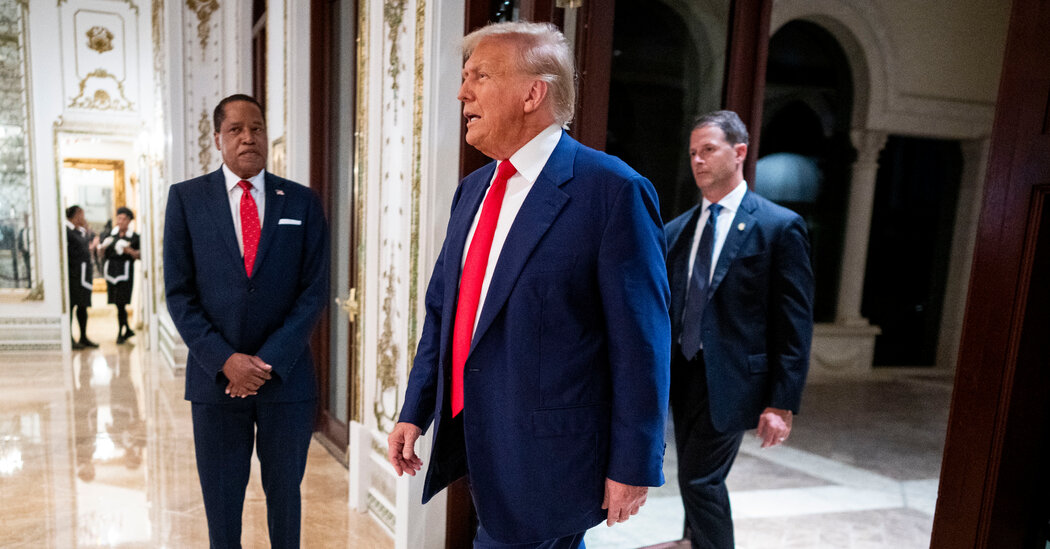C.B.P. Was Created With a Terrorism Focus. Now It Must Also Care for Migrants.
On a 90-degree day in early May, hundreds of migrants were gathered on American soil near a border gate in El Paso. Many had waited for days, without food, shelter or enough water and bathrooms, before Border Patrol agents allowed them through the gate and took them to holding facilities.
A few miles away, in the air-conditioned El Paso Convention Center, senior government officials and security contractors were gathered for an annual event showcasing the latest technology for helping to secure America’s borders: robotic dogs, surveillance towers, rugged-terrain equipment, drones and counter-drones.
The contrast in scenes illustrates a central challenge of Customs and Border Protection’s mission. The agency, which includes the Border Patrol, was created after the Sept. 11, 2001 attacks. Its website reads, “Our top priority is to keep terrorists and their weapons from entering the United States.”
While its mission has remained the same over the years, its responsibilities have grown. In addition to securing the border, one of the most pressing issues it has faced in the past decade is a humanitarian one, driven by people coming across the border, many of whom are fleeing violence and poverty. Even as few pose security threats, the American government has been sending the biggest law enforcement agency in the country to arrest and subsequently care for refugees.
“We have to evolve, extremely rapidly,” Manuel Padilla Jr., an assistant C.B.P. commissioner, told the convention center crowd of contractors selling military-grade equipment in May. “And that’s on the migration piece.”
C.B.P., the Homeland Security Department and the White House declined to comment on the record about the situation in El Paso.
The agency’s budget has always been heavily geared toward securing the border. For example, the agency has invested in counter-drone equipment that could detect and take down a cartel-operated drone. By comparison, a minuscule amount of the budget goes toward providing shelter and care for influxes of haggard migrants.
Though some senior officials have privately acknowledged a need to evolve, Mr. Padilla’s public sentiment is not universally shared.
Some in the Border Patrol rank and file want to focus on the agency’s primary mission: “to detect and prevent the illegal entry of individuals into the United States,” not caring for them after they break the law. Some see the humanitarian mission as an invitation for more illegal immigration. Republicans want agents to enforce the law, even though it is decades out of date.
These disagreements are just one piece of the larger, volatile debate over the country’s immigration policies. Even so, scenes of thousands of desperate migrants turning themselves into Border Patrol agents have become the face of it.
When C.B.P. first saw this migration trend in 2014, some officials believed that other federal agencies, like the Federal Emergency Management Agency and Health and Human Services, would be better suited to lead the response.
Gil Kerlikowske, the C.B.P. commissioner during the Obama administration, said that idea was not welcome when he brought the issue to senior officials. “This is the border, and this is your problem,” he said he was told.
In that sense, not much has changed.
The Homeland Security Department, where C.B.P. resides, can request assistance from other federal agencies during times of high illegal crossings. But in the end, it is C.B.P.’s responsibility.
Successive administrations have focused on ways to decrease the number of illegal crossings and avoid a humanitarian crisis on the U.S. side of the border.
The Trump administration rolled out punitive policies to deter migrants from crossing the border, in one case, by separating families, and in others, by restricting access to asylum.
The Biden administration, which has witnessed the largest influx of migrant crossings at the southern border at a time when more people are displaced globally than ever before, has focused on narrowing eligibility for asylum and adding some new legal pathways to enter the country.
But because such policies are set by the executive branch and change frequently, a lasting effect is unlikely.
Without the political will to reorganize C.B.P. to support its humanitarian mission, the agency will likely continue to rely on temporary solutions, as it has for the past decade.
When spikes in migration threaten to overwhelm resources, C.B.P. can add temporary holding facilities. The agency has also made significant progress since 2014 in ensuring the facilities are more appropriate for children and stocked facilities with food, water, baby formula, diapers and other necessities.
C.B.P. has hired hundreds of people to process migrants and perform administrative work, relieving Border Patrol agents who had been temporarily reassigned to these roles. And President Biden requested a $4.7 billion emergency reserve for the 2024 fiscal year to make it easier to access funds in a crisis.
The flaws in this ad hoc response were evident in El Paso ahead of the expiration of a pandemic-era health measure known as Title 42 in early May. The Biden administration had spent nearly two years planning for the policy’s expiration, which they expected would bring its biggest influx of migrants yet. Officials predicted that El Paso would be one of the most popular crossing points.
Yet hundreds of migrants, many of whom made long and dangerous journeys to get to the United States, waited behind a border gate, where they were largely shielded from public view. The border facilities were full.
By the time some migrants arrived at the C.B.P. processing centers, they were so dehydrated and matted with sand that agents struggled to get their fingerprints, according to the U.S. official, who was not authorized to speak publicly and described the situation on the condition of anonymity.
C.B.P. did not say how many people had been waiting for days. A senior official said there was no formal decision to hold migrants outdoors for extended periods when facilities were out of space. There was a similar situation in San Diego. The official, authorized only to speak anonymously, defended the agency’s response and its delivery of supplies to those held outdoors in El Paso. Another C.B.P. official, also speaking on the condition of anonymity, said the agency had an obligation to provide appropriate care for the migrants, but doing so was difficult given that the top priority was moving them from the border and into a holding facility.
Hours before the change in border policies on May 11, Raul Ortiz, the recently retired Border Patrol chief, stood near the gate in El Paso that prevented about 1,000 migrants from walking further into the country. At times that week there were more than 2,500 people there, he said, yet supplies were only delivered that afternoon.
The backup in sending the migrants to facilities was a far cry from the vision Mr. Ortiz described at the expo center a day earlier. “I want our processing facilities to be run like Chick-fil-As,” he said, a reference to the fast food chain’s quick service.
Refugee response should be an established part of the agency, Mr. Ortiz said.
“You have a border security mission, and you have a humanitarian mission, and they sometimes collide,” Mr. Ortiz said at the El Paso security expo in May. “But as a leader of the Border Patrol and my fellow chiefs, we want to try and figure out how to manage those equally. And then you have to evolve as an organization.”
That could include, for example, the creation of a dedicated emergency response division or other force within C.B.P. trained to manage an influx of refugees. But a concerted push for such a change has not appeared.
“That’s a piece that has never been focused on by any administration,” said Andrea Flores, a former White House official who worked on these issues in the Obama and Biden administrations.
Justin Hamel contributed reporting.


